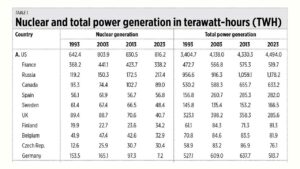Last week I attended two energy fora. The first was the Stratbase-Citizen Watch forum, “Advancing Energy Security: Fueling Sustainable Progress with Liquefied Natural Gas (LNG),” on June 18 at the Asian Institute of Management Conference Center, Makati. The second was the Philippine Chamber of Commerce and Industry (PCCI) Power Summit 2024 with the theme, “Moving the Economy Forward with Energy and Power Security and Competitiveness,” on June 19 at the Makati Diamond Residences.
The keynote message for the first forum was delivered via video by Energy Secretary Raphael P.M. Lotilla. The other speakers were Majah-Leah Ravago, President and CEO of the Development Academy of the Philippines; Dominic Camu, the COO of Global Business Power; Carlos Aboitiz, Chief Corporate Services Officer of Aboitiz Power Corp.; and Donnabel Kuizon Cruz, Managing Director and General Manager of Prime Infrastructure Capital, Inc. The opening message was given by Victor Andres “Dindo” Manhit, President of the Stratbase ADR Institute and the closing remarks were given by former congressman Jose Christopher “Kit” Belmonte, Convenor of CitizenWatch.
The keynote messages at the PCCI Power Summit were given by PCCI Chairman and Director for Energy and Power George T. Barcelon, Mr. Lotilla again, and Energy Regulatory Commission Chairperson and CEO Monalisa Dimalanta.
The panel discussion at the PCCI event was composed of key corporate leaders from five areas of the power supply chain. For power generation it was Francis Giles Puno, President and COO of First Gen Energy Solutions, Inc.; for transmission, Redi Allan B. Remoroza, Assistant Vice-President and Head of Transmission Planning of National Grid Corp. of the Philippines (NGCP) and Vincent Harvey C. Bernabe, Central Grid Operations Manager of NGCP; for distribution, Lawrence S. Fernandez, VP and Head of Utility Economics of Meralco; for supply, Raymond Carl R. Roseus, President of the Retail Electricity Suppliers Association of the Philippines; and for large consumers, Lloyd Balajadia, PCCI Chairman for Manufacturing. The panel’s moderator was Carlos Ramon C. Aboitiz of Aboitiz Power who is also the PCCI Co-Chair for Energy and Power.
I liked Mr. Aboitiz’ opening message when he was introducing the panel. He said that “The country will need all forms of energy capacities and technologies — from traditional, renewable, and even energy storage… an ‘all-options-on-the-table’ approach [that] also presupposes that the country prepares now for emerging long-term projects and developments — like a national nuclear program or manpower reskilling and capacity building — in order to be ready when the right opportunities come our way.”
And speaking of nuclear energy, on June 20, the Statistical Review of World Energy (SRWE) 2024 was released by the Energy Institute in London. It is a rich source of country level annual data from 1985 to 2023, with some data stretching back as far as 1965.
I downloaded the database in Excel file form and checked the nuclear power generation of major countries. There were five surprises.
First, Germany, which had its peak nuclear generation of 171 terawatt-hours (TWh) in 2001 was generating only 35 TWh in 2022 and 7 TWh in 2023, going back to its level in 1970 of 6.5 TWh. They shut down their last remaining nuclear power plants in April 2023.
Second was that the United Arab Emirates (UAE), whose nuclear generation until 2019 was zero, started with 1.6 TWh in 2020, which quickly jumped to 20 TWh in 2022 and 32 TWh in 2023.
The third surprise was that Japan, which started nuclear generation in 1966, had its peak production at 326 TWh in 1998. This went down to zero in 2014 after the big earthquake and Fukushima accident in 2011. It rose to 61 TWh in 2021 and 78 TWh in 2023.
The fourth was that Pakistan, which generated only 4 TWh in 2013, jumped to 22 TWh in 2023.
And the fifth surprise was that Taiwan, which had a high of 42 TWh in 2013, was down to only 18 TWH in 2023. Their government plans to phase out all their nuclear power plants by 2025.
The biggest nuclear power producer in the world is the US with 816 TWh in 2023, followed by China, France, Russia, and South Korea. But when it comes to total power generation — including all power sources like coal, gas, hydro, etc. — the biggest is China with 9,456 TWh in 2023, followed by the US, India, Russia, and Japan (see Table 1).
I computed the nuclear/total generation ratio of the various countries and saw the biggest was still France with 65% in 2023, followed by Finland, Belgium, and the Czech Republic. In Asia the most nuclear power intensive country is South Korea with 29%.
Finally, I computed the GDP growth performance of these countries. One weak trend seen in the data is that as countries move away from cheap and reliable nuclear power, their average growth declines or remains low, like in Germany and the UK. Meanwhile Asian countries with rising or a high nuclear share in power generation had high GDP growth, like South Korea and China (see Table 2).
I participated in the Philippines Nuclear Trade Mission to Canada back in March in Toronto, organized by the Canada embassy in Manila. I was one of four Philippine media people who joined the mission, which was led by Energy Undersecretary Sharon Garin and Science Undersecretary Leah Buendia. It was a very educational trip on nuclear energy policy and power plant operation.
The Philippines’ power demand is rising by around 7-8 TWh/year but its supply is rising only by 6 TWh/year, and the gap of 1-2 TWh/year is reflected as frequent thin reserves, yellow-red alerts, and high electricity prices. So, we need nuclear energy to augment the existing power supply.
Today, June 25, the Ambassador of Canada to the Philippines David Hartman will lead the celebrations of Canada Day in Manila and the 75th Anniversary of Diplomatic Relations between Canada and the Philippines. It will be held at the Grand Hyatt Hotel in BGC, Taguig City. Canada is not among the top 20 trade partners of the Philippines, but I hope it will be among the top five partners of the Philippines when it comes to nuclear energy development.
Bienvenido S. Oplas, Jr. is the president of Bienvenido S. Oplas, Jr. Research Consultancy Services, and Minimal Government Thinkers. He is an international fellow of the Tholos Foundation.





